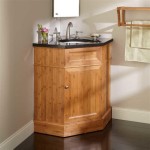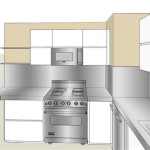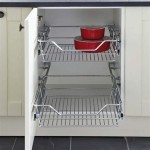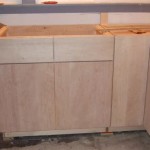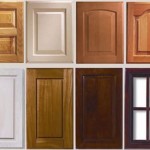Transform Your Home With Tilt-Out Trash Can Cabinets Ideas
Household waste disposal, while a necessary element of daily life, often presents challenges in terms of space management and aesthetic appeal. Traditional trash cans can be bulky, unsightly, and prone to emitting unpleasant odors. A tilt-out trash can cabinet offers a practical and visually appealing alternative, seamlessly integrating waste management into a home's design. This article explores various tilt-out trash can cabinet ideas, examining their benefits, design options, and installation considerations.
Tilt-out trash can cabinets function by concealing a standard trash receptacle within a cabinet enclosure. The front panel of the cabinet tilts outward, allowing for easy access to the can for waste disposal. When closed, the cabinet presents a clean, streamlined appearance, effectively hiding the trash can from view. These cabinets are available in a range of sizes, materials, and styles, making them suitable for different rooms and design preferences. The primary advantage of a tilt-out trash can cabinet lies in its ability to improve the overall aesthetics of a space by minimizing the visual impact of waste disposal.
Space Optimization and Functional Design
One of the most compelling reasons to consider a tilt-out trash can cabinet is its space-saving potential. In kitchens, bathrooms, and laundry rooms, floor space is often at a premium. Traditional freestanding trash cans can occupy valuable real estate, hindering movement and workflow. A tilt-out cabinet effectively addresses this issue by utilizing vertical space, incorporating the trash receptacle into existing cabinetry or creating a standalone unit that minimizes its footprint. These cabinets also contribute to a cleaner and more organized environment by containing spills and preventing the trash can from being knocked over or moved unintentionally.
Within the realm of space optimization, it's important to consider the various design adaptations available. Wall-mounted tilt-out cabinets are particularly well-suited for smaller spaces, such as bathrooms or apartments, where every square inch counts. These units are attached directly to the wall, freeing up floor space entirely. For larger kitchens or areas with ample room, floor-standing tilt-out cabinets offer greater storage capacity and can be designed to complement existing kitchen cabinetry seamlessly. Some models even incorporate additional storage drawers or shelves above the trash compartment, further enhancing their functionality.
The functional design of a tilt-out trash can cabinet extends beyond mere space saving. Many models incorporate features that improve hygiene and ease of use. For example, some cabinets are equipped with soft-close hinges, preventing the door from slamming shut and reducing noise. Others feature removable liners or compartments that facilitate easy cleaning and prevent odors from accumulating. Selecting a cabinet with such features can significantly enhance the overall user experience, making waste disposal a more convenient and sanitary process.
Furthermore, the selection of the appropriate trash can liner or receptacle significantly contributes to the cabinet's functionality. Ensuring that the liner fits snugly within the designated compartment prevents leaks and spills, minimizing the need for frequent cleaning. Heavy-duty liners are particularly useful for handling heavier or sharper waste items, reducing the risk of tearing or punctures. Some tilt-out cabinets are designed to accommodate dual receptacles, allowing for convenient sorting of recyclable materials from general waste, promoting environmentally responsible waste management practices.
Aesthetic Integration and Material Options
Beyond its functional benefits, a tilt-out trash can cabinet offers a significant advantage in terms of aesthetic integration. Unlike conventional trash cans, which often detract from a room's decor, a tilt-out cabinet can be designed to seamlessly blend into its surroundings. The cabinet's exterior can be customized to match existing cabinetry, flooring, or wall colors, creating a cohesive and visually appealing space. This integration transforms waste disposal from an eyesore into an intentional element of the overall design.
The choice of materials plays a crucial role in achieving this aesthetic integration. Wood cabinets, for instance, offer a classic and timeless look that complements a wide range of interior styles. Solid wood cabinets are particularly durable and long-lasting, while those constructed from engineered wood products, such as MDF (medium-density fiberboard) or plywood, offer a more affordable alternative. These materials can be painted or stained to match existing cabinetry, ensuring a seamless transition.
Metal cabinets, on the other hand, offer a more contemporary and industrial aesthetic. Stainless steel cabinets are a popular choice for modern kitchens, providing a sleek and durable surface that is easy to clean. Powder-coated metal cabinets are available in a variety of colors, allowing for greater customization. These cabinets are often resistant to scratches and dents, making them a suitable option for high-traffic areas.
In addition to wood and metal, other materials, such as bamboo or recycled plastics, can be used to construct tilt-out trash can cabinets. Bamboo offers a sustainable and eco-friendly alternative to traditional hardwoods, providing a warm and natural aesthetic. Recycled plastics are another environmentally conscious option, diverting waste from landfills and reducing the environmental impact of manufacturing. When selecting a cabinet material, it's important to consider not only its aesthetic appeal but also its durability, maintenance requirements, and environmental impact.
The design of the cabinet's door or front panel can also contribute to its aesthetic integration. Shaker-style doors, with their clean lines and recessed panels, are a popular choice for transitional kitchens. Raised-panel doors offer a more traditional and ornate look, while flat-panel doors provide a minimalist and contemporary aesthetic. The addition of decorative hardware, such as knobs or pulls, can further enhance the cabinet's overall appearance, tying it into the existing design scheme.
Installation Considerations and Maintenance
Proper installation is essential for ensuring the functionality and longevity of a tilt-out trash can cabinet. The installation process will vary depending on the type of cabinet and the specific installation requirements of the chosen model. Wall-mounted cabinets typically require anchoring to wall studs for stability, while floor-standing cabinets may require assembly and leveling. It is important to carefully follow the manufacturer's instructions to avoid damaging the cabinet or the surrounding surfaces.
Before beginning the installation process, it is crucial to carefully measure the available space and ensure that the chosen cabinet will fit comfortably. Consider factors such as door clearances, countertop overhangs, and existing plumbing or electrical fixtures. It may be necessary to relocate existing obstacles or modify the cabinet's design to accommodate specific spatial constraints. Professional installation is recommended for individuals who lack experience with carpentry or plumbing.
Once installed, regular maintenance is necessary to keep the tilt-out trash can cabinet in good condition. This includes wiping down the cabinet's exterior with a damp cloth to remove dirt and debris. For wooden cabinets, it may be necessary to occasionally apply a furniture polish or sealant to protect the wood from moisture and scratches. Metal cabinets can be cleaned with a stainless steel cleaner or a mild detergent.
The interior of the cabinet should also be cleaned regularly to prevent odors from accumulating. This can be done by wiping down the surfaces with a disinfectant cleaner or by using a baking soda solution to absorb odors. Replacing the trash can liner frequently and using odor-absorbing gels or sprays can also help to maintain a fresh and sanitary environment. Addressing spills or leaks promptly is essential to prevent staining or damage to the cabinet's interior.
In addition to regular cleaning, it is important to inspect the cabinet's hardware periodically to ensure that it is in good working order. Tighten any loose screws or bolts and lubricate hinges or drawer slides as needed. Replacing worn or damaged hardware can improve the cabinet's functionality and prolong its lifespan. By following these maintenance guidelines, it is possible to keep a tilt-out trash can cabinet in excellent condition for many years, ensuring its continued functionality and aesthetic appeal.
Finally, consider the long-term use and durability of the chosen tilt-out trash can cabinet. Selecting a cabinet constructed from high-quality materials and with sturdy hardware will ensure that it can withstand the rigors of daily use. Investing in a durable and well-maintained cabinet will not only improve the appearance and functionality of a home but also provide a cost-effective waste management solution in the long run. Before purchase, read reviews and consider manufacturer warranties to ensure satisfaction.

How To Build A Custom Tilt Out Trash Cabinet Abby Organizes

Kitchen Trash Can Ideas Florence Revival

How To Build A Custom Tilt Out Trash Cabinet Abby Organizes

Diy Kitchen Island With Trash Storage Shades Of Blue Interiors

Build Your Own Pull Out Trash Drawer Crystel Montengro Home

Wastebasket Cabinet Pull Out Storage For Trash Recycling

Kitchen Trash Can Ideas Florence Revival

How To Build A Custom Tilt Out Trash Cabinet Abby Organizes

Diy Tilt Out Cabinet Handmade Weekly

Diy Pull Out Trash Can Fixthisbuildthat
Related Posts


